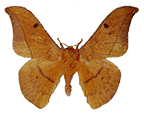|
Cricula trifenestrata Helfer
Saturnia trifenestrata Helfer, 1837, J. Asiat. Soc. Bengal, 6: 45.
Cricula andrei sensu Holloway, 1976: 85.
Cricula trifenestrata Helfer; Holloway, 1981: 122; Allen, 1981: 120;
Lampe, 1985: 15.

Cricula trifenestrata ♂
(.65
natural size) |

Cricula trifenestrata ♀
(.73
natural size) |
 |
Diagnosis. The next two species are very similar:
bornea can only be
distinguished on genitalic features as described for that species; elaezia
is darker, less orange; in Bornean elaezia the two fasciae of the hindwing
converge anteriorly just before the costa or are joined by a diffuse, dark
bar at their nearest point; the aedeagus vesica lacks cornuti, and the
juxta differs significantly. No reliable characteristics for
distinguishing the females have yet been discovered.
Taxonomic notes. The status of many taxa currently subordinated to
trifenestrata is being investigated by W. Nassig. Therefore only the
original descriptions and references to recent records for Borneo are
listed above. See also Holloway (1981). Male specimens from the Bornean
lowlands have two approximately equal hyaline spots on the forewing; those
from montane forests have the posterior one reduced (Holloway, 1981)
Geographical range. Indian Subregion to Philippines, Sulawesi and Java.
Habitat preference. The species ranges from the lowlands to over 2000m.
Biology. The larva was illustrated by Horsfield & Moore (1858-1859)
(Java). It is shown as dark grey with T3 and the anal claspers red. There
is a sublateral pink stripe, and the venter is black. Each segment is
ringed with setose verrucae. Gardiner (1982) states each segment is
clothed in yellow-brown hair, and the segments are separated by dark brown
rings.
The
cocoon is a fusiform, yellow network of silk.
Recorded host-plants (Sevastopulo, 1940; Pholboon, 1965; Browne, 1968;
Arora & Gupta, 1979; Bell, MS; CIE records) are as follows: Anacardium,
Mangifera, Spondias (Anacardiaceae); Careya (Barringtoniaceae);
Bishchofia
(Bischofiaceae); Canarium (Burseraceae); Quercus (Fagaceae);
Cinnamomum,
Machilus, Persea (Lauraceae); Acrocarpus (Leguminosae); Ziziphus
(Rhamnaceae);
Malus, Prunus, Pyrus (Rosaceae); Salix (Salicaceae); Schleichera
(Sapindaceae).
<<Back
>>Forward <<Return to Contents page
|

